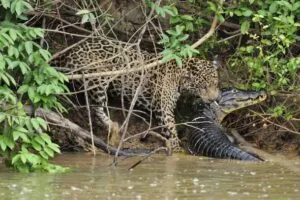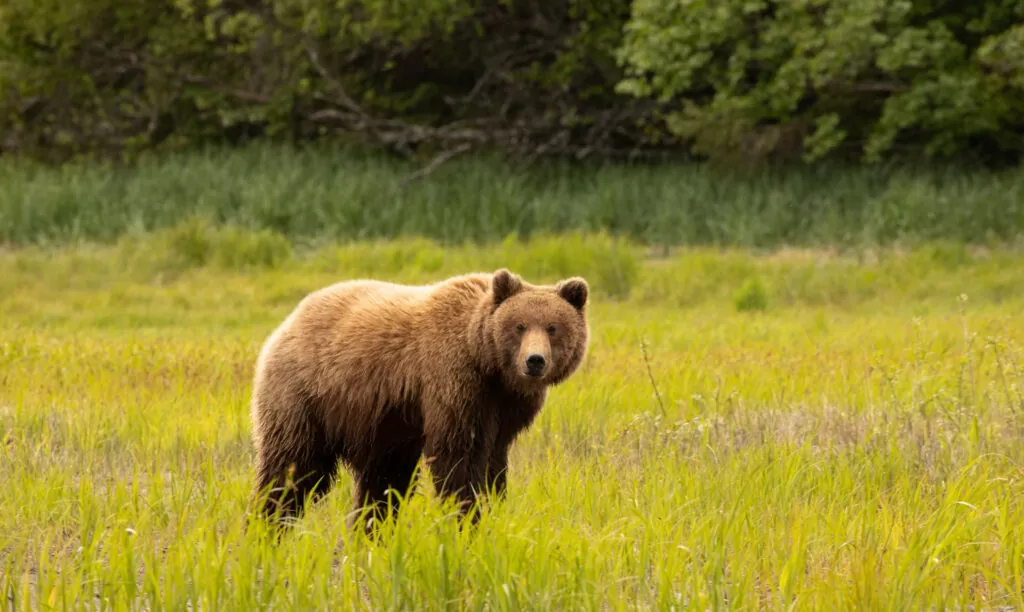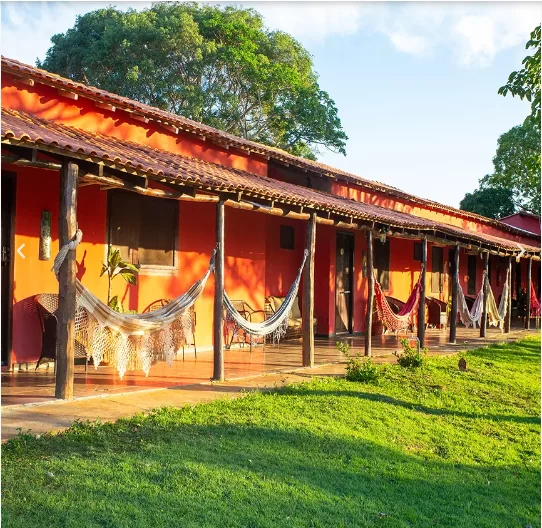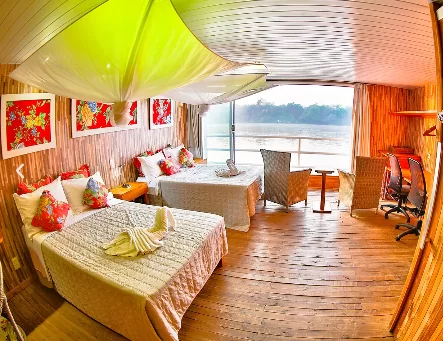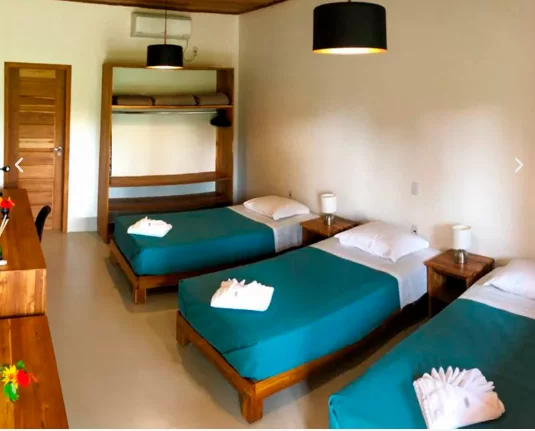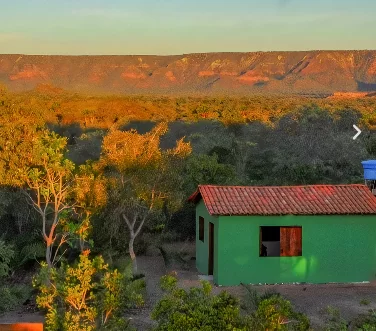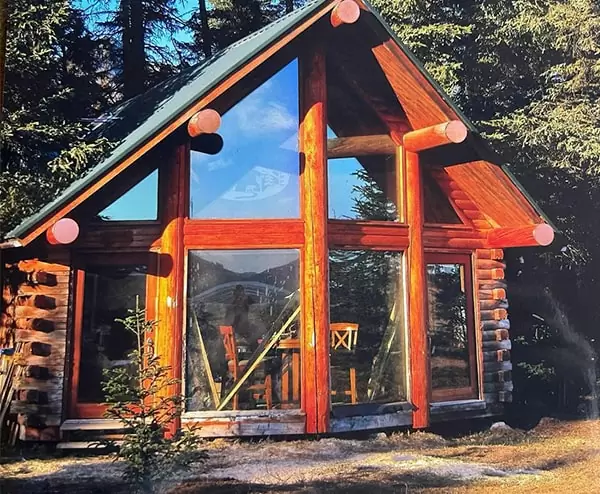Wolf Camps
SouthWild Wolf Camps
Maned Wolves Guaranteed
Our aptly-named Wolf Camps are the only lodges in the world that guarantee viewing in wild habitat of the world’s most elegant, tallest wild canid, the endangered Maned Wolf.
Hyacinth Macaws Guaranteed
Wolf Camps are the only lodges in the world that guarantee viewing of flocks of 15-25 or more of Hyacinth Macaws cracking their favorite wild palm nuts on the ground in perfect natural habitat.
TV Star Monkeys
See at close range the world’s most complex tool use of any of the world’s 267 monkeys species. As seen on BBC and Nat Geo TV, Bearded Capuchins use special, igneous hammer rocks to crack palm nuts on sandstone anvil rocks.
Striking scenery: 1,000-foot-tall Red Rock Cliffs & Palm-lined Valleys
The 1,000-foot-tall (300 metre-tall) Red Rock Cliffs of one of Brazil’s largest national parks frame the palm-lined, savanna valleys, making for photogenic scenery.
Blue-and-Gold and Red-and-Green Macaws, Seriemas, Burrowing Owls, and King Vultures.
WC features a series of other very colorful, iconic neotropical birds in specially-selected, wild settings perfect for photography
Spacious, private bungalows in paradise.
Our 350-square-foot private bungalows with en suite facilities are set in miraculously-mosquito-free tropical savanna reserves with surprisingly-cool nights perfect for sleeping with one or two blankets. Many birds and Tufted-eared Marmosets grace feeders near the lodge.
SouthWild Wolf Camps Accommodations
- Each camp has 7 rooms of 35 sq. m. (350 sq ft) each ensuite bathrooms with sun-heated showers.
- Huge, open-air, unscreened dining rooms at each camp, with views of the surrounding forest or cliffs at Wolf Valley Camps and Wolf Cliffs Camps, respectively.
- Located in private properties of 2,500 acres and 10,000 acres immediatley-adjacent to and in the middle of the 1.7-million-acre Parnaíba River Headwaters National Park, Brazil’s second-large national park outside the Amazon rainforest.
The seven private bungalows at each of the two Wolf Camps each have en suite facilities and sun-heated showers that are best enjoyed in the afternoon or early evening before the water cools off. Each bungalow is 350 square feet inside and has enormous windows to gaze out at tropical nature.
Wolf Valley Camp has feeders in natural habitat near the lodge with colorful birds and even delightful Tufted-eared Marmosets. The feeders at Wolf Cliff Camps have fewer species of birds and no marmosets.
Wolf Cliffs Camp, however, has particularly-spectacular red cliff scenery visible from the bungalows and from the clearing where guests dine in a large, roofed, open-air dining room.
Maned Wolves often visit the edge of the clearing and even walk through the unfenced Wolf Cliffs Camp, much to the delight of the amazed guests. Despite the fact that the Maned Wolf is as tall as a Great Dane, it only weighs 25-28 kilos, (55-61 pounds) as it is extremely slim and stands on tall, slender legs. This species of wolf is naturally very shy and hunts alone, with its favorite prey being small and medium-sized rodents and birds.
Although we offer to hang mosquito nets, the spacious guest rooms do not require them, as no matter the month, there are no mosquitoes at Wolf Camps. Additionally, there are no insect-borne maladies in the entire region.
The rooms are so large that it is easy to relax and spread out all your gear there.
When to visit SouthWild Wolf Camps
The best months for visiting the Wolf Camps are May through August. These are the months in which very little rain falls and in which the nighttime temperatures are deliciously-cool thanks to the relatively high elevation of the camps, meaning 3,000 feet of elevation and the fact that is the austral “winter”. Located at only 7 degrees south of the equator, however, “winter” means only cooler temperatures and dry, sunny weather.
Another reason that those months are best is that if there are going to any dry season forest fires, they almost always occur in late September and October, prior to the rains of December through March.
The huge, tasty meals are served at the Wolf Camps in the enormous, open-air dining rooms with birds easily seen from the table. The particularly-tasty repertoire of home-cooked meals are prepared by the family of the former animal trapper turned conservationist. The personalized service and the delicious and varied dishes are delightful. Consistently our guests at the Wolf Camps say they enjoyed the wildlife, scenery, and particularly the personalized service at the camps even more than their outstanding times with Jaguars in the Pantanal.
SouthWild Wolf Camps Activities
Our Wolf Camps offer a greater variety of exciting wildlife and walks than you will find at any other dry tropical forest in the Americas. We list the activities briefly, and then describe the top four of them in more detail.
- Viewing and photography (“V&P”) of Maned Wolves during the night and often even during the day for 15-30 minutes on most days. Our guests admire the wolves from as close as only 4-20 meters in natural habitat.
- V&P of flocks of 15-25 Hyacinth Macaws on the ground and in low bushes and trees from only 9-25 meters. Sometimes the flocks are larger, in the range of 25-40 birds. Once, we had 105 Hyacinths at one moment all within view simultaneously at our viewing location, but that is not normal.
- V&P of the world-famous Bearded Capuchin Monkeys cracking rock-hard, golf-ball-sized palm nuts using special hammer rocks that these ingenious monkeys brought from who knows where and use on traditional sandstone “anvil rocks”. Our guests view this unique behavior from only 4-15 meters and without the use of a blind (hide). This is the most complex tool use of any of the world’s 267 species of monkeys.
- Charming, hyperenergetic Tufted-eared Marmosets at 4-12 meters at eye level in natural habitat at Wolf Valley Camp.
- VKing Vultures at 25-50 m in natural, dry forest habitat.
- Red-and-Green and Blue-and-Gold Macaws and Sun Parakeets at distance of 20-100m.
- Burrowing Owls in natural habitat at 9-20 meters.
Details of the activities.
✓ Maned Wolves are visible at close range at WCC on most nights from May through August and even sometimes pose right next to the individual guest bungalows. Most visits by the wolf or wolves of the day are near sunset or near sunrise. The wolves are not aggressive at all towards humans, but rather, extremely timid and polite, so there is no danger at all. Never in 17 years of guaranteeing Maned Wolves at the Wolf Camps has a wolf threatened any person, and they never will.
✓ To our surprise, in 2016 a very cute Hoary Fox started to visit Wolf Valley Camp regularly, and it or its friends have been visiting ever since. WVC is the only place in the world featuring this beautiful canid.
✓ Hyacinth Macaws are happy to gather at a natural location that is a five-minute drive from Wolf Valley Camp. They gather to forage on their traditional palm nuts, which are the same rock-hard nuts that are cracked by the Bearded Capuchins. These most powerful of all macaws take approximately six minutes to crack and to slice in two each of these immensely-hard nuts. Inside, they find energy-rich nut meat that looks and tastes just like coconut meat.
In 2006, our researcher spent two months photographing the macaws that came to the foraging spot near WVC and documented 167 different, individually-identifiable Hyacinth Macaws. The birds were distinguished by 600-mm lens photographs of their beaks, each of which had unique cracks, lines and other minor imperfections that allowed positive ID.
It requires patience to photograph these cobalt-blue macaws at their foraging spot, as they often take an hour to gather the confidence to descend to the ground for the nuts.
✓ The famous nut-cracking Bearded Capuchin Monkeys of Wolf Valley Camp are in fact a 25-minute drive away, in a rocky dry forest nook. We leave Wolf Valley Camp after breakfast to drive to the spot and then walk 200 metres or so to find the monkeys. The monkeys are perfectly prepared to display their nut-cracking skills only a few metres from our little stools. It is amazing to watch these most intelligent of all monkeys choose their special hammer rocks like tools in their tool kit and to do full-body lifts of the heavy rocks and to bring them with all their strength to crack the extremely hard, golf-ball-sized palm nuts.
It is especially fascinating to watch young monkeys observing older group members cracking nuts with these hammer rocks. The young monkeys take many months of practice and observation over 3-4 years and then more practice to get strong enough and skilled enough to crack nuts successfully themselves.
See the Facebook page “facebook.com/ethocebus/” for details of the nearly twenty years of scientific research on these famous, tool-using monkeys, who demonstrate the most complex tool use of any of the world’s 267 species of monkeys. In the early 2000’s, the former animal trappers of Wolf Camps first showed these amazing, tool-using monkeys to Charles Munn, who then placed the first note about this in the international press, specifically in National Geographic Magazine. Sine then, these monkeys have appeared countless times worldwide in TV documentaries by BBC and Nat Geo.
The viewing of the Maned Wolves and of the tool-using capuchin monkeys now is from very short distances such that at least in the case of the monkeys, one should use safety glasses to make sure that flying shards of shells of the palm nuts do not hit you in the eye!
The combination of stunning scenery, private, up-close viewing and photography of spectacular, rare wildlife, lack of biting insects, delicious, personalized meal services, and wonderfully-cool sleeping without any need for air conditioning makes the Wolf Camps unique in the world.

